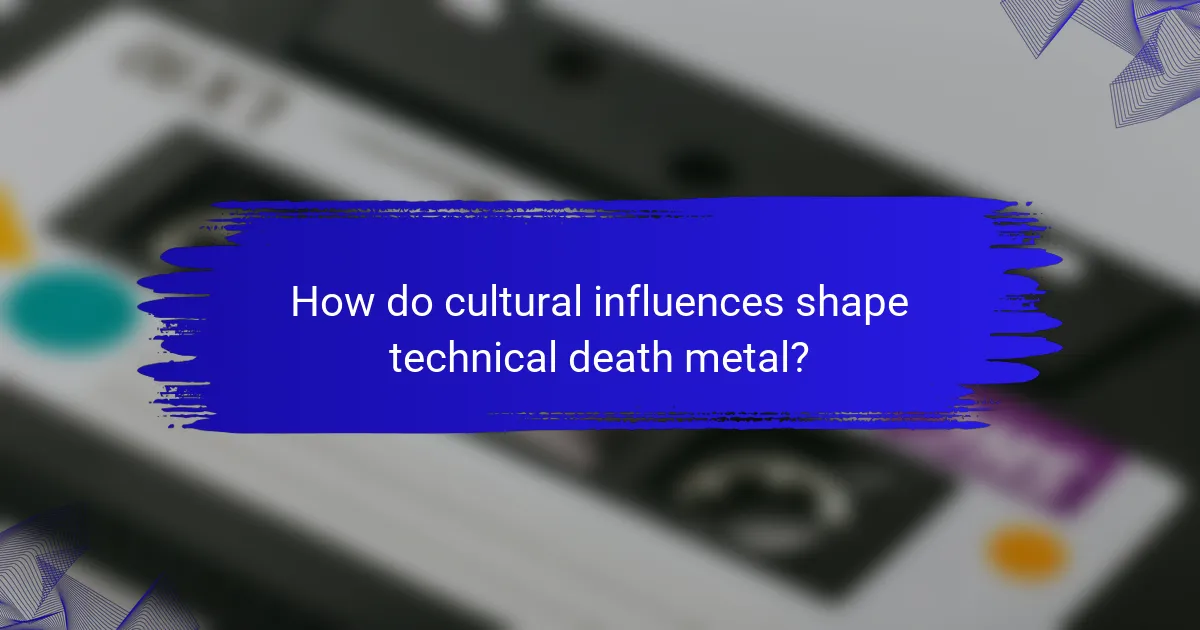Technical death metal musicianship is characterized by intricate compositions and advanced techniques that define the genre. This article explores the complexity of song structures, highlights landmark albums like “Symbolic” by Death and “Focus” by Cynic, and examines the influence of cultural elements on the music. Additionally, it discusses the importance of live performances and offers guidance for aspiring musicians to master the genre’s unique attributes.

What defines musicianship in technical death metal?
Musicianship in technical death metal is defined by intricate compositions, advanced techniques, and exceptional musicianship. The genre showcases complex time signatures, rapid tempo changes, and sophisticated guitar work. Landmark albums like “Symbolic” by Death and “Focus” by Cynic exemplify these traits, pushing boundaries in musical complexity. Technical proficiency in instruments and a deep understanding of music theory are essential attributes that set this genre apart.
How do technical skills differentiate musicians?
Technical skills distinguish musicians by enabling complex compositions and intricate performances. In technical death metal, musicianship involves advanced techniques like polyrhythms, sweep picking, and intricate time signatures. Landmark albums, such as “Symbolic” by Death and “Focus” by Cynic, showcase these skills, highlighting the genre’s complexity. The ability to master these technical elements sets apart musicians, elevating their artistry and influence within the metal community.
Why is complexity valued in technical death metal?
Complexity is highly valued in technical death metal due to its intricate musicianship and challenging compositions. Musicianship showcases advanced skills, including rapid time signatures and complex rhythms. Landmark albums, such as “Focus” by Cynic and “Symbolic” by Death, exemplify these traits, pushing the boundaries of the genre. This complexity attracts listeners who appreciate technical proficiency and the artistic depth it brings to the music.
Which instruments are commonly used in the genre?
Technical death metal commonly utilizes electric guitars, bass guitars, drums, and keyboards. Electric guitars deliver intricate riffs and solos, often using seven or eight strings for added complexity. Bass guitars provide a deep foundation, frequently matching guitar rhythms. Drums feature rapid double bass patterns and complex time signatures. Keyboards occasionally enhance atmospheric elements, contributing to the genre’s depth.

What are the hallmark characteristics of landmark albums?
Landmark albums in technical death metal showcase exceptional musicianship, intricate compositions, and innovative soundscapes. These albums often feature complex time signatures and virtuoso instrumental performances, defining the genre’s evolution.
Key characteristics include:
– **Musicianship**: High levels of technical skill among musicians, often including rapid guitar solos and intricate drumming patterns.
– **Complexity**: Layered arrangements that challenge traditional song structures, incorporating diverse influences.
– **Production Quality**: Superior audio engineering that highlights the nuances of each instrument, enhancing the listening experience.
– **Conceptual Depth**: Thematic coherence that often explores philosophical or abstract ideas, engaging listeners on multiple levels.
Albums that exemplify these traits have left a lasting impact, influencing countless artists and shaping the landscape of metal music.
How do landmark albums influence the genre’s evolution?
Landmark albums significantly influence the evolution of technical death metal by pushing musicianship and complexity boundaries. They introduce innovative techniques, intricate song structures, and unique soundscapes that inspire subsequent artists. Albums like “Symbolic” by Death and “Focus” by Cynic set new standards for guitar work and rhythmic complexity. As a result, these records not only shape the genre’s sound but also redefine musicianship expectations, encouraging experimentation and growth within the community. The impact of these albums is evident in the emergence of new subgenres and the continuous evolution of technical proficiency among musicians.
Which albums are considered pivotal in technical death metal?
Key albums pivotal in technical death metal include “Focus” by Cynic, “Symbolic” by Death, and “Obscura” by Gorguts. These albums showcase musicianship and complexity, establishing benchmarks in the genre. “Focus” introduced progressive elements, while “Symbolic” refined melodic structures. “Obscura” pushed boundaries with dissonance and intricate compositions. Each album significantly influenced subsequent technical death metal artists, solidifying their status as landmarks.
What production techniques are prevalent in these albums?
Technical death metal albums often utilize complex production techniques that enhance musicianship. Common methods include intricate layering of instruments, advanced mixing techniques, and the use of digital effects. These techniques contribute to a dense soundscape, allowing for the intricate arrangements typical of the genre. Landmark albums frequently employ unique production styles, such as unconventional time signatures and polyrhythmic structures, showcasing the musicians’ technical prowess.

How does songwriting complexity manifest in technical death metal?
Songwriting complexity in technical death metal manifests through intricate rhythms, unconventional song structures, and advanced musical techniques. Musicians often employ polyrhythms and odd time signatures, creating a unique listening experience. Landmark albums like “Obscura” by Gorguts showcase these complexities, blending dissonance with melodic elements. Additionally, the use of technical proficiency on instruments, such as rapid guitar solos and complex drumming patterns, further elevates the genre’s complexity.
What are common lyrical themes in the genre?
Common lyrical themes in technical death metal include existentialism, philosophical inquiries, and complex narratives. Musicians often explore themes of mortality, the human condition, and abstract concepts. Additionally, some lyrics delve into science fiction and horror, reflecting the genre’s intricate nature. Landmark albums like “Symbolic” by Death and “Focus” by Cynic exemplify these themes through their thought-provoking lyrics and complex compositions.
How do song structures differ from traditional metal?
Technical death metal diverges from traditional metal through its intricate song structures, featuring complex time signatures, unconventional rhythms, and advanced musicianship. This genre emphasizes technical proficiency and compositional experimentation, often incorporating elements like dissonance and polyrhythms. Landmark albums, such as “Symbolic” by Death, showcase these unique attributes, demonstrating a shift towards complexity and depth in songwriting.

Which musicians are recognized for their unique contributions?
Technical death metal musicians recognized for their unique contributions include bands like Death, Cynic, and Obscura. Death pioneered complex song structures and intricate guitar work, particularly in the album “Symbolic.” Cynic introduced progressive elements and jazz influences in “Focus,” while Obscura is known for their technical precision and innovative compositions in “Cosmogenesis.” Each band’s landmark albums showcase their distinctive approaches to musicianship and complexity within the genre.
What are the standout attributes of pioneering artists?
Pioneering artists in technical death metal are distinguished by their musicianship, complexity, and landmark albums. Their technical prowess often includes intricate guitar work, advanced drumming techniques, and unconventional time signatures. Landmark albums, such as “Focus” by Cynic and “Symbolic” by Death, showcase these unique attributes, influencing countless musicians. The genre’s complexity is characterized by shifting dynamics and progressive elements, setting a high standard for creativity and innovation.
How do collaborations shape the sound of technical death metal?
Collaborations significantly influence the sound of technical death metal by merging diverse musical styles and techniques. These partnerships enable musicians to explore complex rhythms and intricate melodies, enhancing the genre’s overall depth. For instance, collaborations with jazz or progressive rock artists introduce unconventional time signatures and improvisational elements, which are rare in traditional death metal. Landmark albums often feature such collaborations, showcasing how they can redefine a band’s sound and push the boundaries of technical musicianship. This blending of influences fosters innovation, leading to unique compositions that resonate with fans and critics alike.

What role does live performance play in musicianship?
Live performance is crucial in technical death metal musicianship as it showcases complexity and musicianship. It allows musicians to demonstrate their technical skills, engage with the audience, and interpret landmark albums in real-time. The energy of live shows often enhances the intricate arrangements unique to this genre, making each performance a distinct experience. Additionally, live settings can reveal rare attributes of musicians, such as improvisational skills and stage presence, which are not always evident in studio recordings. Overall, live performance solidifies a musician’s identity and connection to the genre.
How do technical skills translate to stage presence?
Technical skills enhance stage presence by boosting confidence and performance quality. Technical death metal musicianship involves complex rhythms and intricate solos, allowing musicians to showcase their abilities. This mastery translates to engaging performances, captivating audiences with precision and energy. Landmark albums like “Symbolic” by Death exemplify how technical prowess can elevate live shows, creating memorable experiences. Musicians who excel in technical skills often command attention, as their expertise fosters a strong connection with the audience.
What are the challenges of performing complex compositions live?
Performing complex compositions live presents significant challenges for technical death metal musicians. These challenges include maintaining precision, coordinating with band members, and managing physical endurance.
Precision is crucial as complex rhythms and time signatures require flawless execution. Musicians must master intricate patterns to avoid mistakes during performances. Coordination among band members is essential since complex compositions often involve multiple layers of instrumentation. Each musician must stay in sync to achieve the desired sound.
Physical endurance plays a critical role, as performing demanding pieces can be physically taxing. Musicians must build stamina to sustain high-energy performances over extended periods.
Additionally, the pressure of live settings can lead to performance anxiety, impacting musicians’ ability to deliver complex compositions effectively.

How do cultural influences shape technical death metal?
Cultural influences significantly shape technical death metal through diverse musical traditions and lyrical themes. Musicians draw from various genres, incorporating complex rhythms and intricate guitar work inspired by cultural backgrounds. For instance, the use of Middle Eastern scales can be found in the compositions of some bands, enhancing their uniqueness. Landmark albums like “Focus” by Cynic and “Symbolic” by Death exemplify how cultural elements contribute to the genre’s complexity and musicianship. These influences create a rich tapestry that distinguishes technical death metal within the broader metal scene.
Which regional scenes have contributed to the genre’s diversity?
Various regional scenes have significantly influenced the diversity of technical death metal. The United States, particularly California, introduced complex rhythms and intricate guitar work, exemplified by bands like Death and Atheist. Europe, especially Sweden, contributed melodic elements and progressive influences, showcased by Opeth and Meshuggah. South America, notably Brazil, added a raw intensity and unique cultural flavors, highlighted by bands like Sepultura. These regions have fostered distinct styles, enriching the genre’s overall complexity and musicianship.
How do local audiences respond to technical death metal?
Local audiences generally respond positively to technical death metal, appreciating its musicianship and complexity. The genre’s intricate compositions and technical prowess attract dedicated fans. Landmark albums, such as “Symbolic” by Death and “Focus” by Cynic, showcase these attributes, influencing local scenes. Additionally, regional variations in audience response highlight unique cultural contexts, enriching the genre’s appeal.

What are the best practices for aspiring technical death metal musicians?
Aspiring technical death metal musicians should focus on mastering complex rhythms, advanced techniques, and music theory. Practice regularly, study landmark albums for inspiration, and collaborate with other musicians. Listening to influential bands like Death, Obscura, and Necrophagist helps understand the genre’s intricacies. Developing a unique sound while honing skills is essential for success.
How can musicians develop their technical skills effectively?
Musicians can develop their technical skills effectively by focusing on structured practice, studying landmark albums, and analyzing complex compositions. Regularly practicing scales and techniques enhances dexterity and precision. Engaging with influential technical death metal albums, such as “Symbolic” by Death or “Focus” by Cynic, provides insights into advanced musicianship. Additionally, collaborating with skilled musicians fosters growth through shared knowledge and feedback.
What common mistakes should be avoided in songwriting?
To avoid common mistakes in songwriting, focus on clarity, originality, and structure. Many musicians neglect these aspects, leading to uninspired or confusing compositions.
First, ensure your lyrics convey a clear message. Ambiguous or overly complex lyrics can alienate listeners. Second, strive for originality. Repeating clichés or imitating popular songs can diminish your unique voice. Lastly, maintain a solid structure. A lack of organization can disrupt the flow and coherence of your song, making it hard for listeners to engage.
By emphasizing these elements, you can enhance your songwriting and create more impactful music.
How can musicians stay relevant in a constantly evolving genre?
Musicians can stay relevant in technical death metal by embracing innovation and mastering complexity. They should continuously evolve their skills and adapt to new influences. Collaborating with artists from different genres can introduce fresh ideas. Additionally, analyzing landmark albums can provide insights into successful techniques and trends. Engaging with fans through social media and live performances enhances connection and relevance.